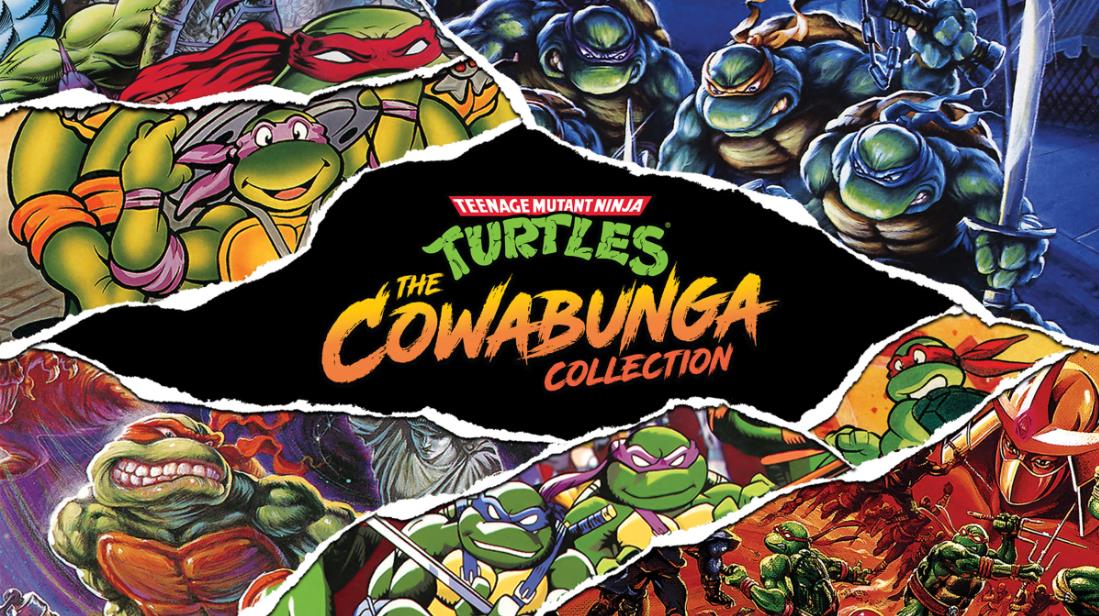
Konami’s arcade games were a staple for any kid growing up in the 90s. They were legends for their licensed arcade cabinets based off properties like The Simpsons, Aliens, Wild West C.O.W.-Boys of Moo Mesa, Bucky O’Hare and X-Men. Teenage Mutant Ninja Turtles was easily the biggest force to reckon with when it came to a media juggernaut and Konami was there to pick up the IP and make the games.
Teenage Mutant Ninja Turtles: The Cowabunga Collection is a compilation of the Konami Teenage Mutant Ninja Turtles games that span from 1989 to 1993, totaling at a whopping 13 games. While some of these games may not hold up to the scrutiny of modern standards, a majority of them are still very enjoyable and are otherwise unobtainable and extremely rare today.
Which games hold up and which don’t? Have any been misunderstood? Were some of these games grossly overrated? Find out in the Teenage Mutant Ninja Turtles: The Cowabunga Collection review!
This is a review coupled with a supplemental video review. You can watch the video review or read the full review of the game below:
Teenage Mutant Ninja Turtles: The Cowabunga Collection
Developer: Digital Eclipse
Publisher: Konami
Platforms: Microsoft Windows, PlayStation 4, PlayStation 5 (reviewed), Nintendo Switch, Xbox One, Xbox Series X|S
Release Date: August 30, 2022
Players: 1-4 (local/online)
Price: $39.99 USD
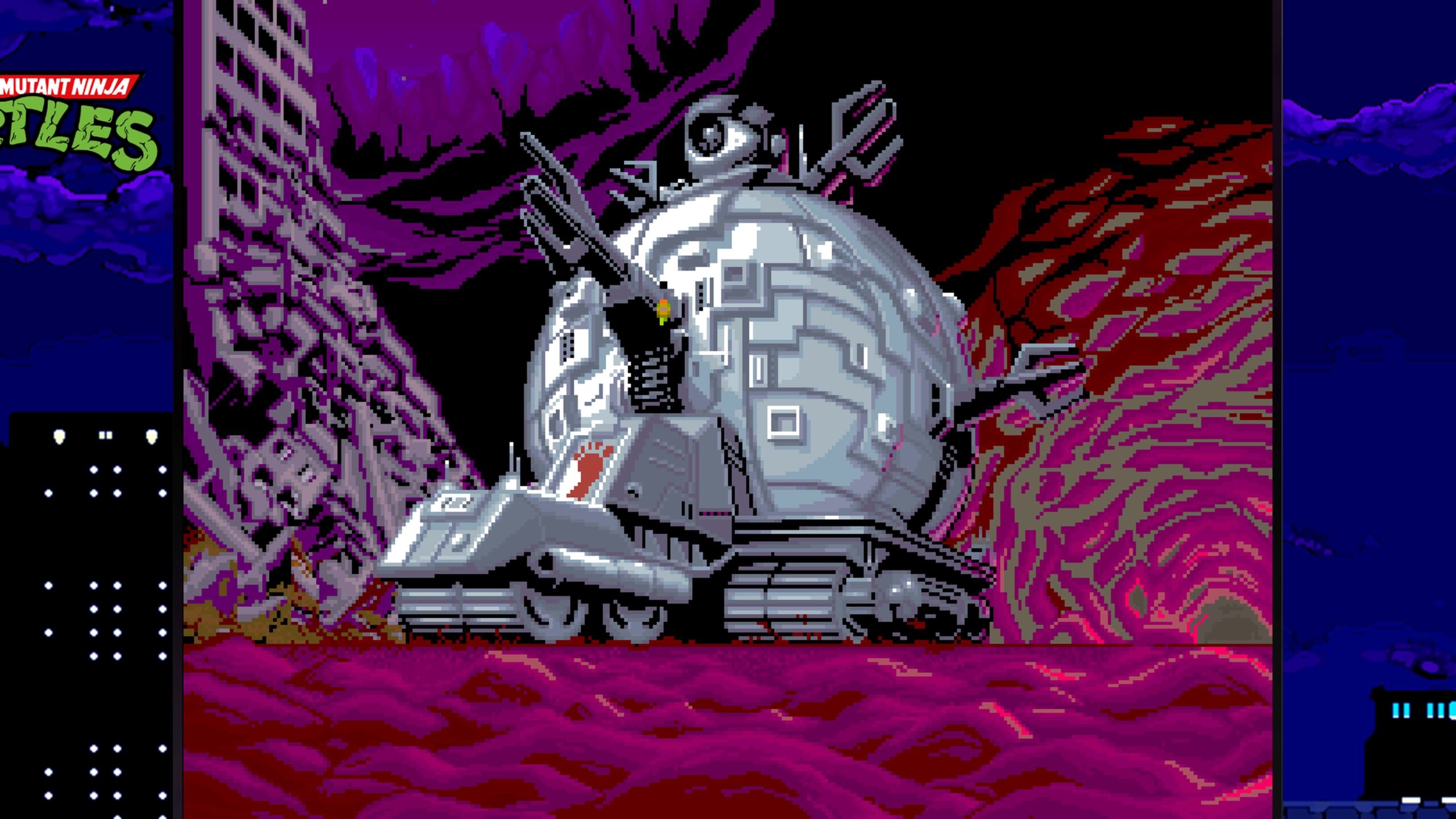
Of the 13 games in the Teenage Mutant Ninja Turtles: The Cowabunga Collection, six are beaten-ups, four are action platformers and three are fighting games. A majority of the games use the 1987 cartoon as a basis for the visual style and identity. There are some fleeting instances of references to Teenage Mutant Ninja Turtles movies, the toy-line and sometimes homages to the comics.
The arcade games look impressively vibrant and have large sprites. The animation is fluid and bosses have an imposing presence when they make their entrances; often with sampled voiced audio to mock the turtles as the battle begins.
Regretfully, the arcade games become tedious slogs. These games were designed to suck quarters out of kids in the 90s and were balanced to be hard. The Cowabunga Collection offers several features to make these entires a bit more fair like a tweaked difficulty and being able to have infinite credits. When players have such vulgar power, the flaws of the arcade games stand out.
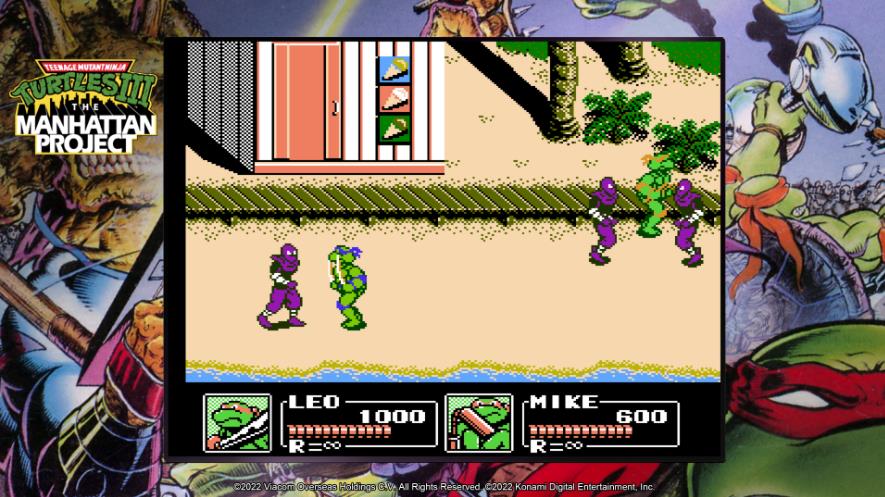
Bosses take a long time to defeat due to the outrageously padded HP pools. Gamers initiated with belt-scrolling beatem-ups will know that most enemies (bosses included) are vulnerable to the “vertical trick”. This method still works to cheese enemies by moving up or down on the y-axis; confusing the foes and putting players into safety.
With infinite credits, the insane challenge and unfair odds may no apply, but the gameplay becomes a tedious battle of attrition. Even when you know how to avoid getting hit and know when to wail on an enemy, the process is dragged out far too long. Compounded with very simplistic gameplay, the arcade games do not hold up after decades of refined game design for the beat-em up genre.
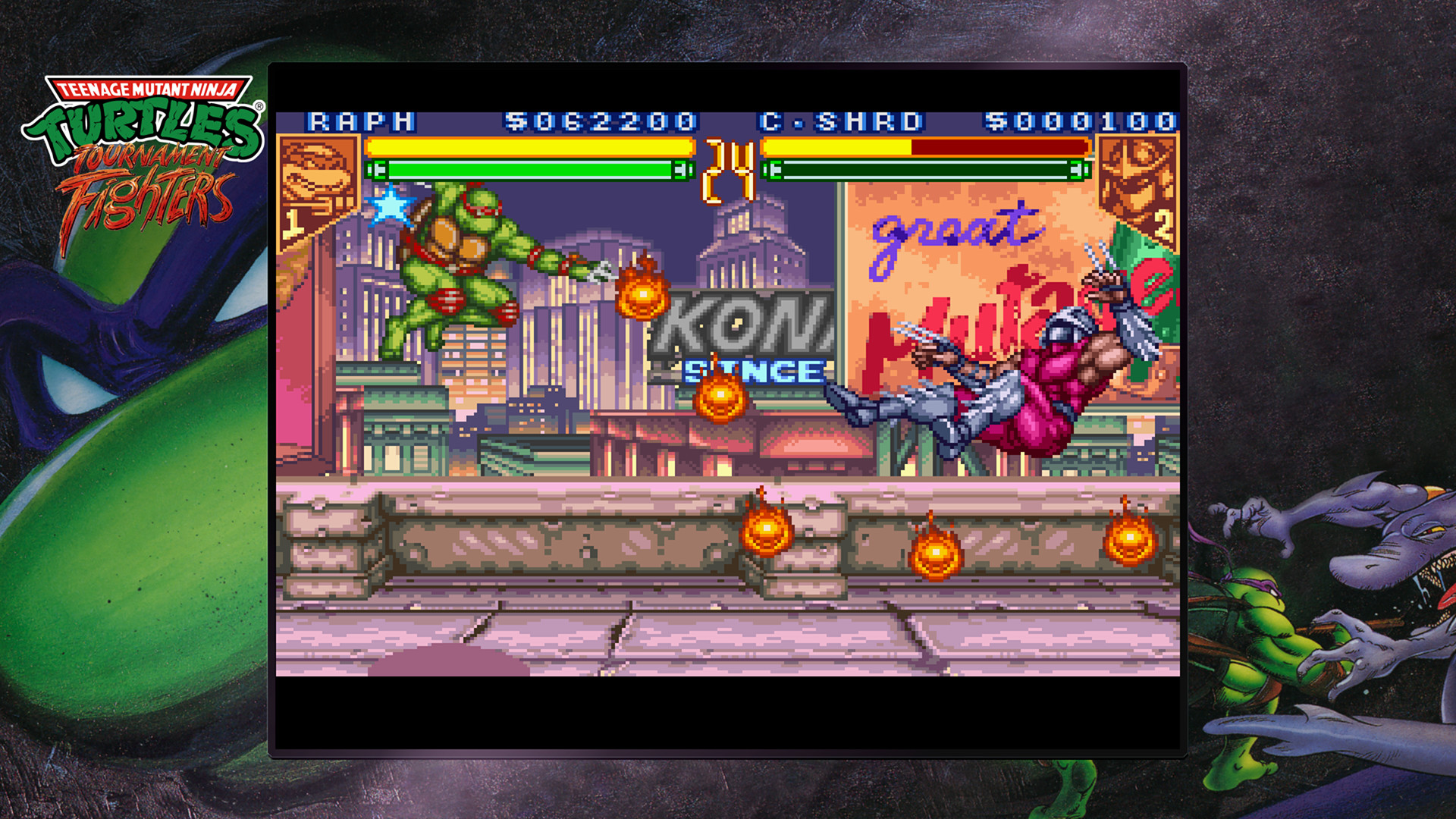
While there is not enough substance or variety in Teenage Mutant Ninja Turtles and Teenage Mutant Ninja Turtles: Turtles in Time for the arcade, the home console games were a big deal in the 90s for being improvements in almost every way imaginable.
Teenage Mutant Ninja Turtles II: The Arcade Game was an ambitious attempt to adapt the original 1989 arcade game and was largely successful. The visuals obviously had to be reimagined to work within the confines of the NES’ limitations like the 8-bits and meager 56 colors. Teenage Mutant Ninja Turtles II: The Arcade Game manages to have some of the better visuals on the console with its big sprites and fluid action.
Gameplay in NES version is also improved thanks to the rebalancing that makes the game more fair and some added variety in the form of extra stages, redesigned stages and new bosses. This also applies to Teenage Mutant Ninja Turtles IV: Turtles in Time which was much further expanded compared to its arcade counterpart. Some bosses are replaced with other characters and there are five unique bosses added.
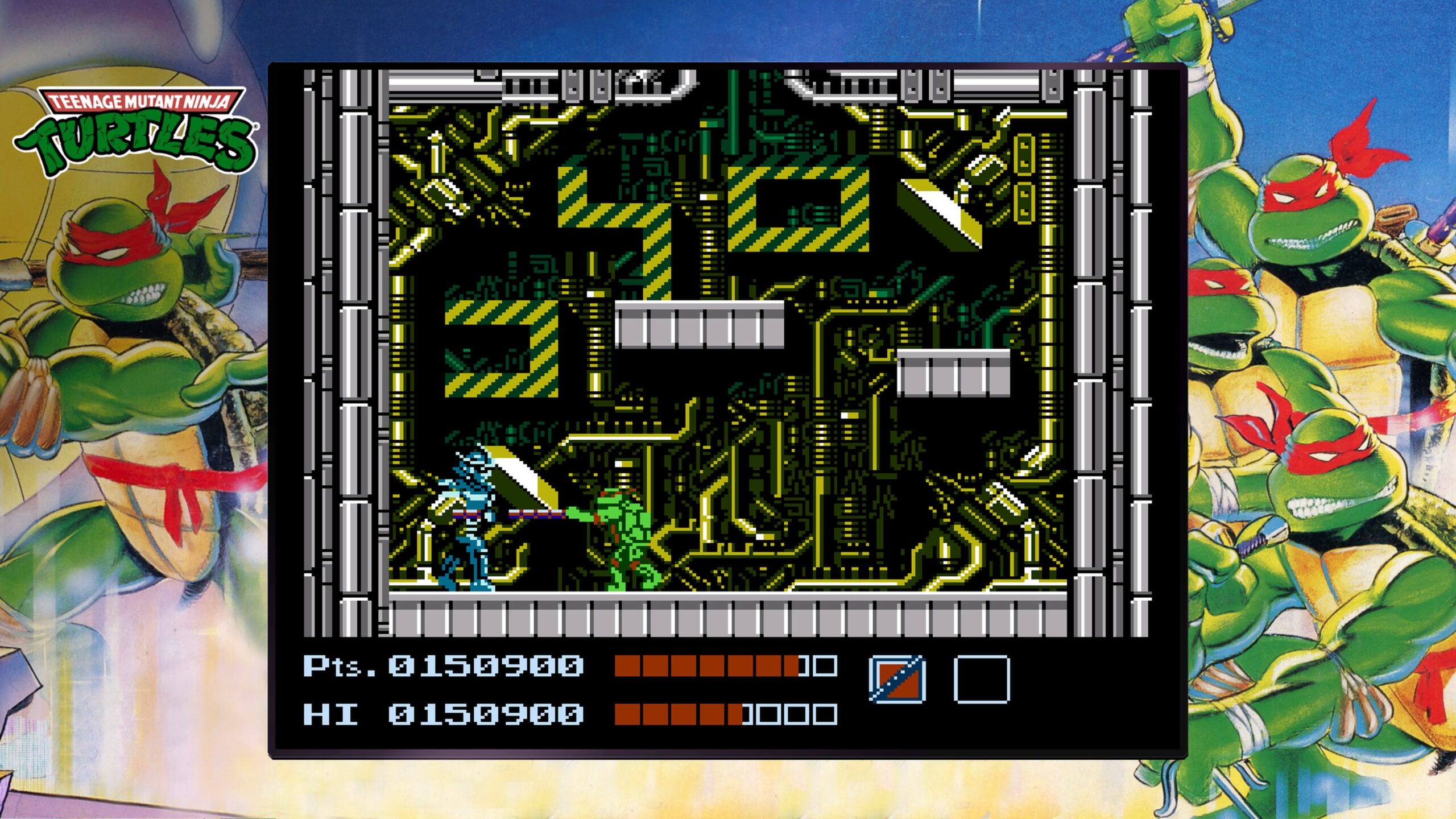
There is a greater attention to detail and small touches that make the SNES version of Turtles in Time the crown jewel in The Cowabunga Collection. Mode 7 effects, improved controls, bonus levels round out the improvements that make it the superior experience over the arcade game and no amount of voice clips will prove otherwise.
The graphics in either Turtles in Time are especially appealing and look as good as the art in Shredder’s Revenge. The toyline seems like it was an influence on the aesthetics; bright colors and shiny highlights that give a plastic-like impression. The Rat-King’s sewer Footski especially looks like the sprite model was modeled directly from its respective toy, with the colors being a 1:1 match.
Teenage Mutant Ninja Turtles (1989) for the Nintendo Entertainment System was not based on any arcade game- it was a single-player action platformer that had more in common with Castlevenia III: Dracula’s Curse. Over the years, this game’s reputation has built it up as one of the hardest games on the NES. The challenge has been grossly overstated and while it is pretty tough, with a bit of practice and patience, anyone can overcome it.
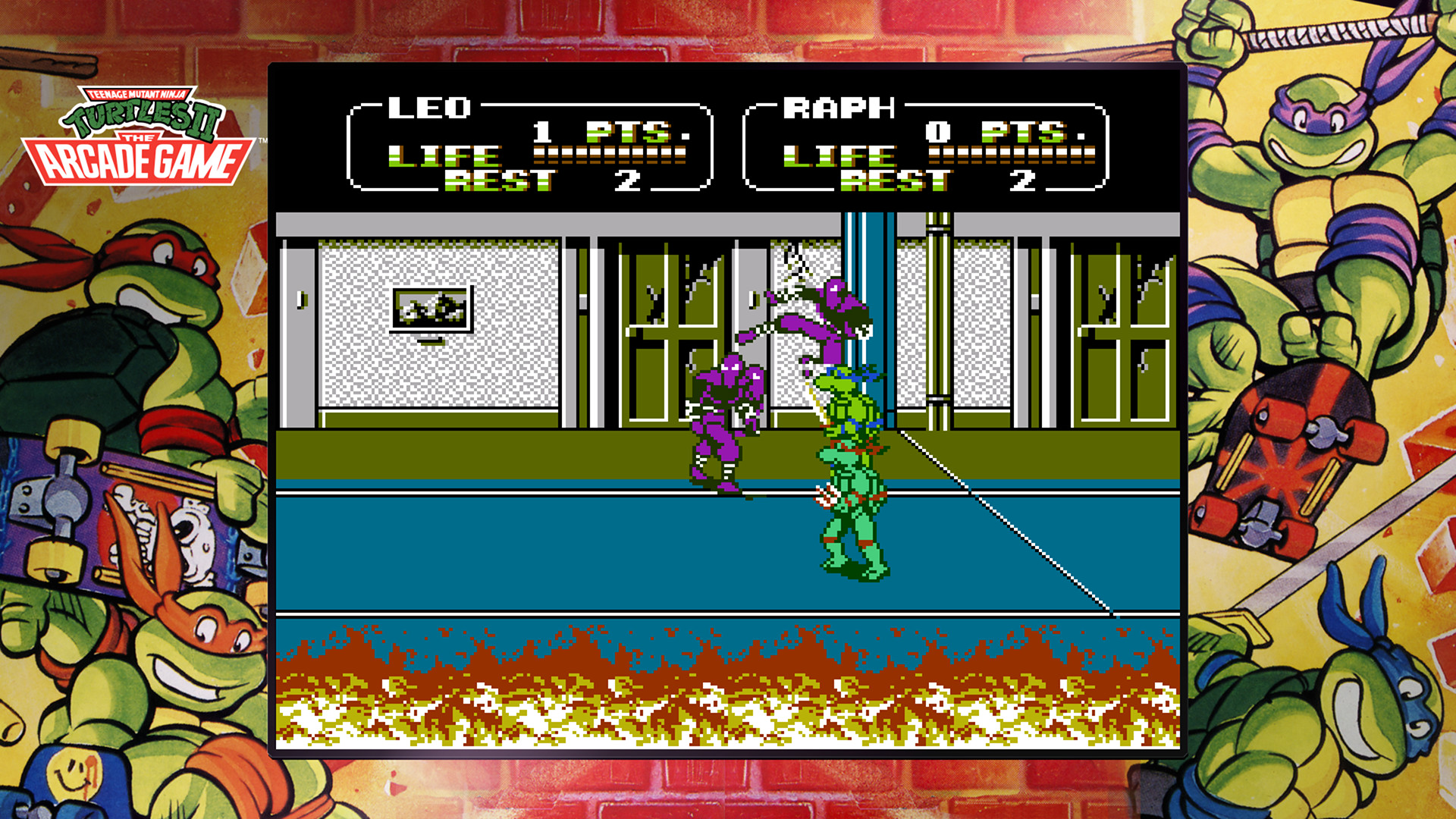
The dam stage has been especially exaggerated with its swimming mechanics, deadly obstacles, ticking time bombs and rushing current. There is admittedly a lot to contend with, but now anyone will be able to beat it thanks to the rewind button and the various cheats that are available. There is no way to lose now.
The graphics in the original Teenage Mutant Ninja Turtles hold up as well as any other Konami NES game. The rich black shadows give the impression of a lot of depth and volume and the turtles look on model for a late 80s 8-bit game. The only questionable choices are some of the generic enemy designs that are indescribable and look like they could be from any game.
Teenage Mutant Ninja Turtles: The Cowabunga Collection also has Teenage Mutant Ninja Turtles III: The Manhattan Project; the longest beat ’em-up in the collection. If you liked Teenage Mutant Ninja Turtles: The Arcade Game on NES, then you’ll loved The Manhattan Project because it is more of it. How much more? It is almost double the size.
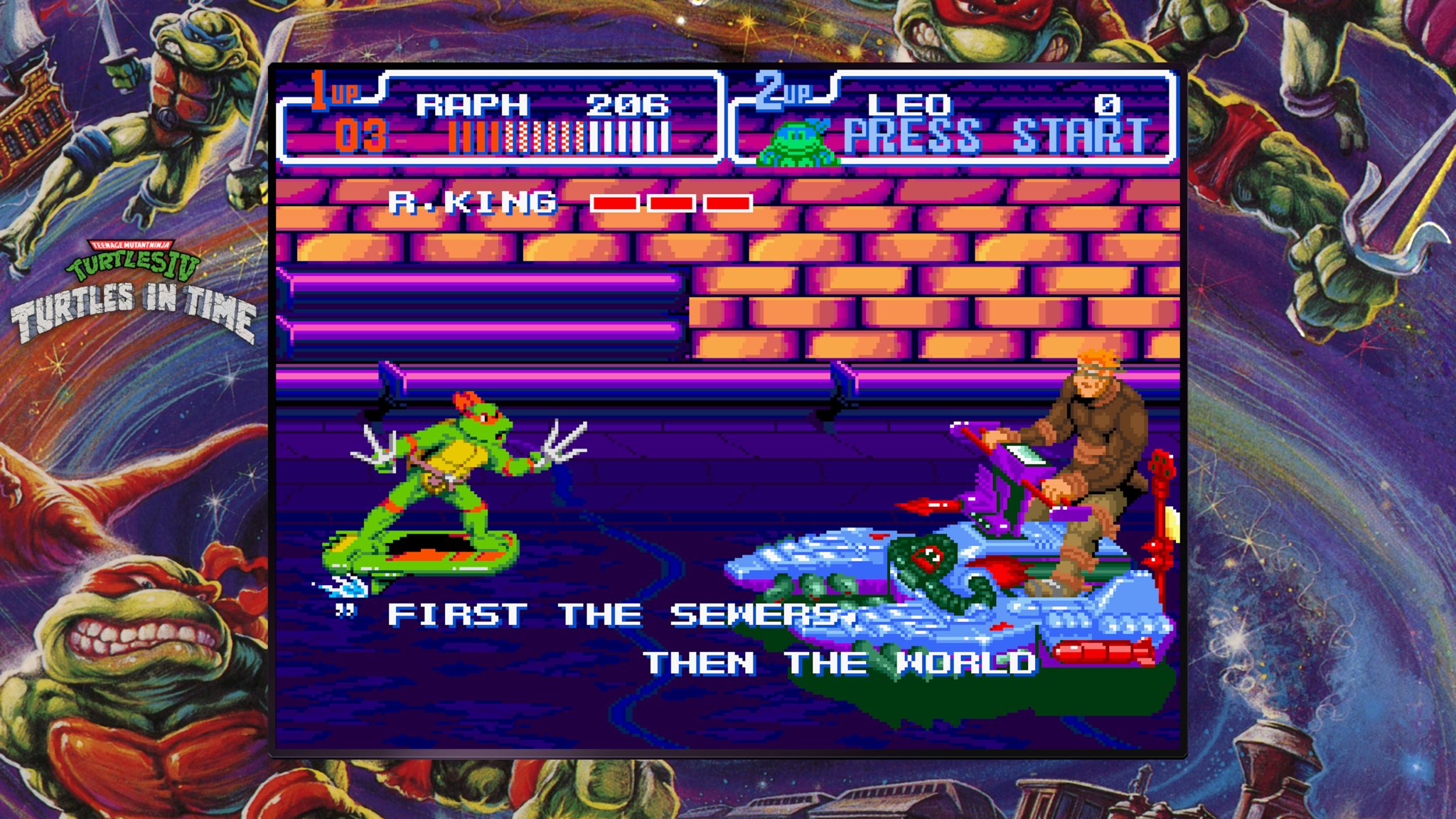
Gameplay mechanics and playability between The Manhattan Project and its predecessor are almost the same, but the former is packed with more stage gimmicks and a lot more bosses. It is so dense and long that it does become a drag after a while and the constant fighting can wear down the player’s patience.
A lot of assets are recycled, but the new additions stand out. The battle with the giant mouser makes an impression and lots of elements from the 2nd movie, The Secret of the Ooze are implemented. The experience feels like an amalgamation of the cartoon show and the films; making it a very comprehensive Turtles beatem-up.
Teenage Mutant Ninja Turtles: The Hyperstone Heist for the Genesis is the final beatem-up in The Cowabunga Collection. This is a weird one, as it is seemingly made up of various aspects of all the prior beatem-up Turtles games in the collection. A lot of Turtles in Time is recycled, but also there are 16-bit reinterpretations of content from Teenage Mutant Ninja Turtles II: The Arcade Game too.
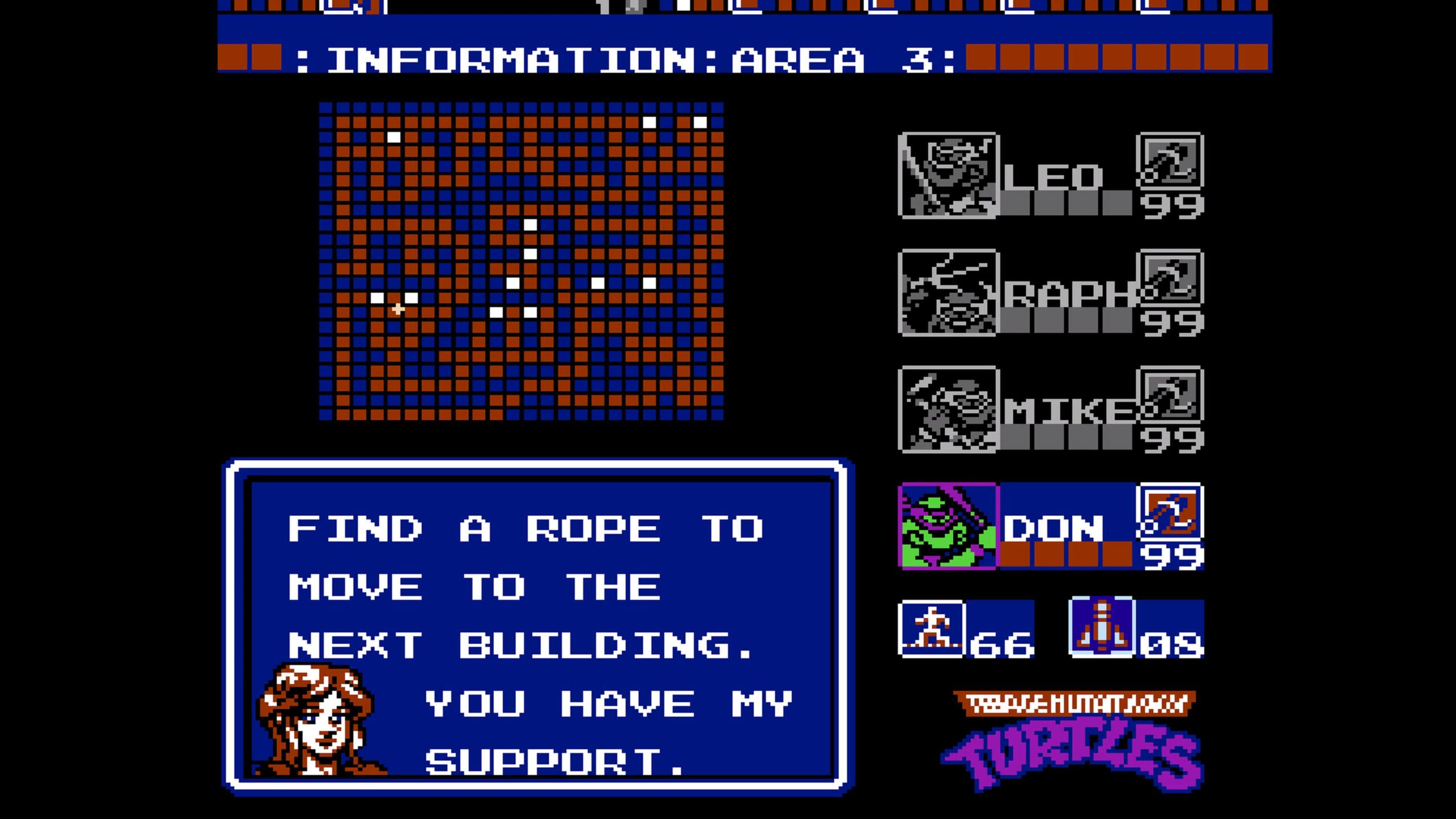
The Hyperstone Heist mixes things up with some gameplay tweaks; most notably that everything feels faster and enemies feel more aggressive. Sadly, there is no throwing Foot Clan ninjas into the screen anymore, but levels are also extended compared to their prior counterparts. Of all the beatem-ups in Teenage Mutant Ninja Turtles: The Cowabunga Collection, this is the most turbo-charged.
Of the three Gameboy titles, only one is of note. Back From the Sewers and Fall of the Foot Clan are where the turtles live up to being turtles and slowly shuffle their way through stages as ninjas rush them. Its hard to cut these titles any slack despite their limitations for being on a monochrome DMG with Gameboy specs, because they are intensely boring.
Aside from some slightly different graphics and unique levels, both Back From the Sewers and Fall of the Foot Clan almost feel like the same game. They are very similar in concept and execution and both games blur together into a black and white haze.
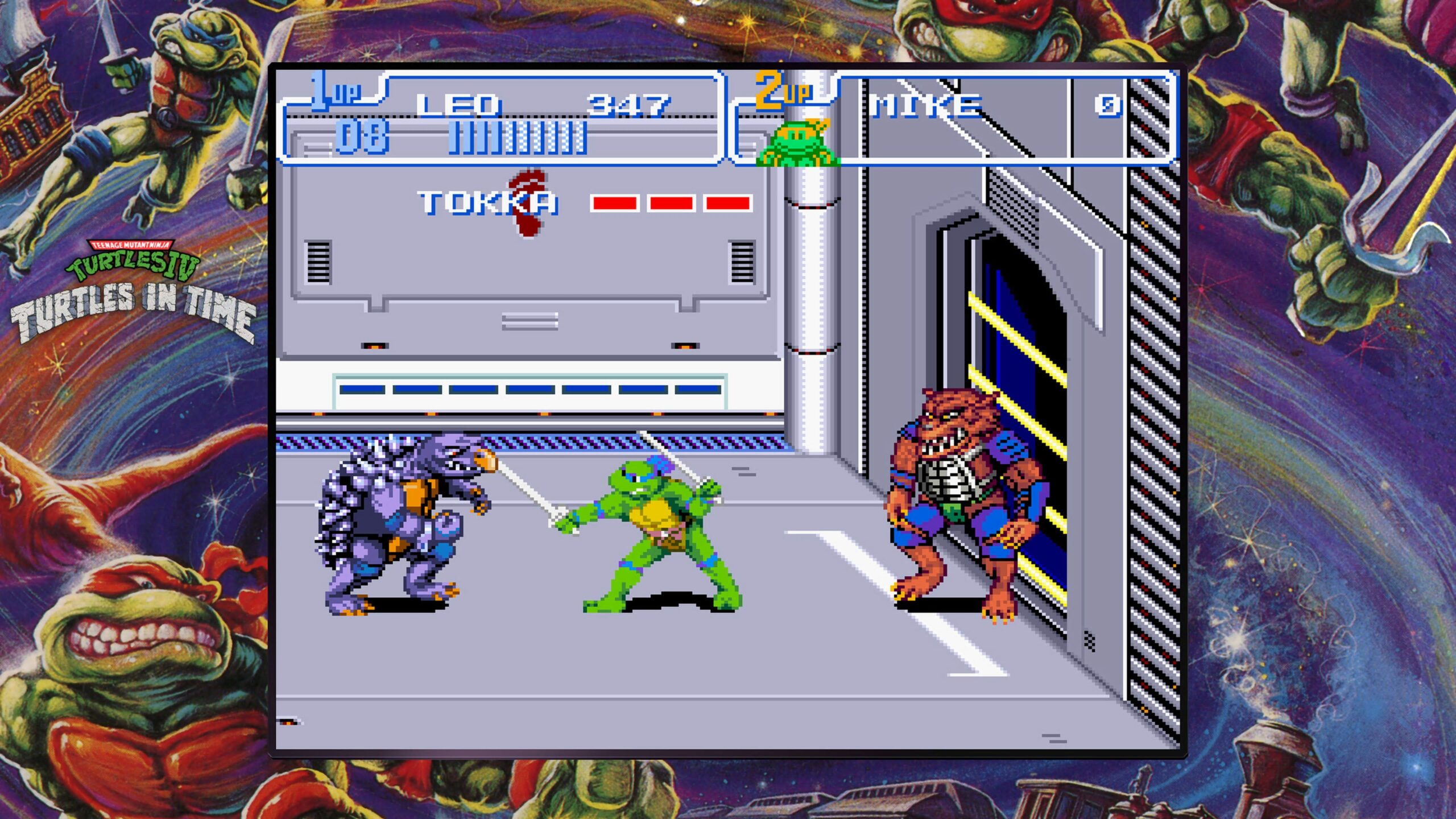
Teenage Mutant Ninja Turtles III: Radical Rescue is the last Gameboy title in the compilation and fares the best, but that isn’t saying much. It is still an action platformer, but this one is notable for having some “metroidvania” elements to the gameplay and is overall a smoother experience compared to the last two Gameboy games.
In Radical Rescue, players begin as Mike and will be exploring open-ended maps. Mike is able to clear large gaps thanks to his whirly nunchuck ability and will have to seek keys through out the game to open up new areas. Areas that are gated off and instead of gaining abilities to bypass these barriers. Abilities are acquired by freeing Mike’s imprisoned brothers.
Raph can go into his shell and get into tight passages like Samus’ morph ball. Leo is able to break blocks by drilling into them with his katanas. Donatello’s talent is scaling up and jumping off walls for hard-to-reach places. Radical Rescue forces players to go into a menu to switch turtles and that can become tedious even in a game as short as this one, which is about three hours.
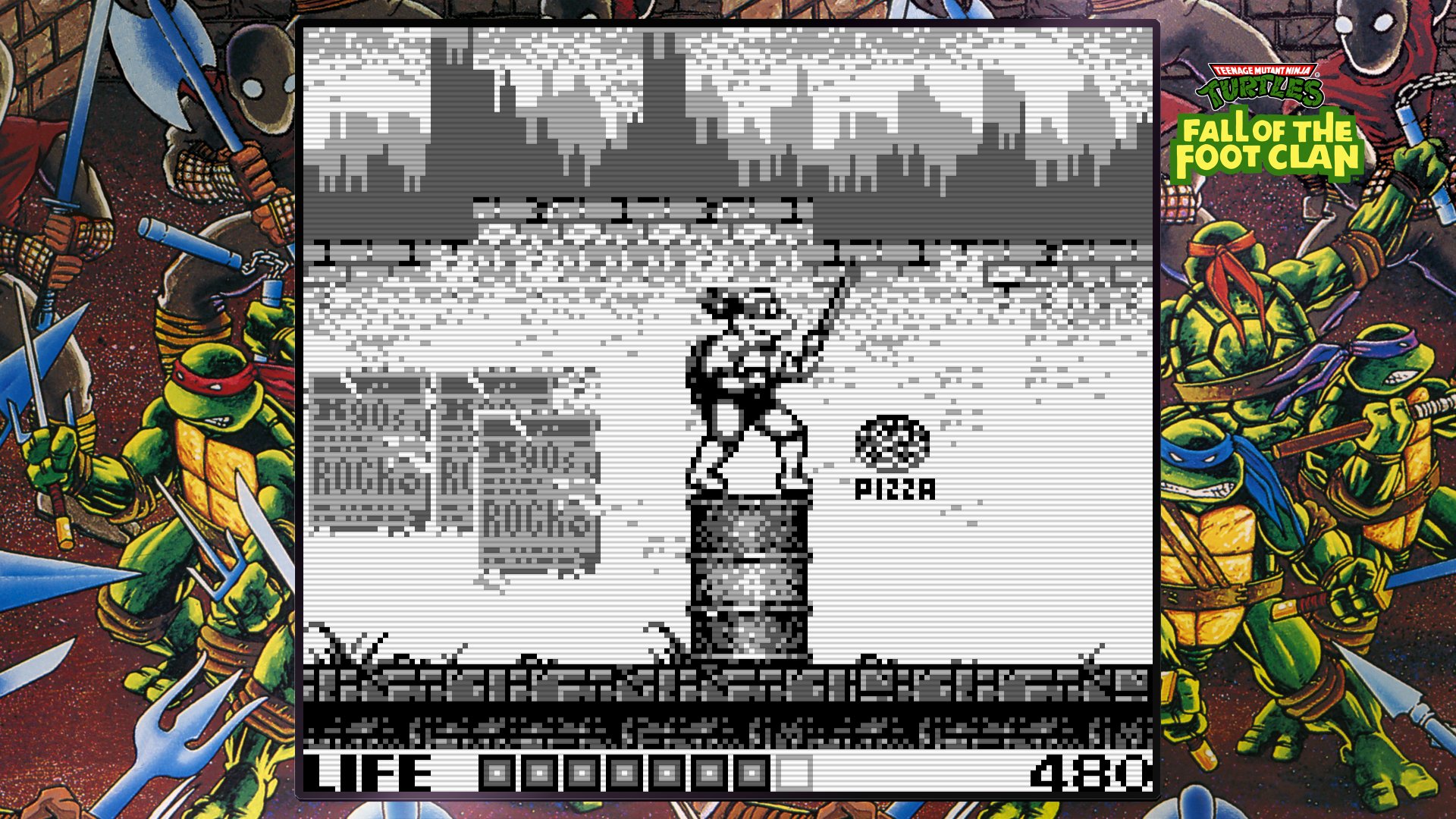
Teenage Mutant Ninja Turtles: The Cowabunga Collection also includes three versions of Teenage Mutant Ninja Turtles: Tournament Fighters for the NES, SNES and Genesis. Only the SNES version is any good because Genesis version was designed around a controller with only three buttons and the NES was the worst console for fighting games.
Between all three Tournament Fighters, each one is still vastly different from the last. The NES version may be borderline unplayable, but it is an impressive technical achievement and pulls off some impressive background scrolling effects that create an illusion of depth. Hothead’s sprite also manages to be so large and nuclear that it is in a constant state of flickering.
Tournament Fighters on Genesis gets two less combatants, than its SNES counterpart, but gets unique stages. Fighters include: Ray Fillet, a big beetle-guy and April; who is modeled after her appearance in the film, Teenage Mutant Ninja Turtles III (1993).
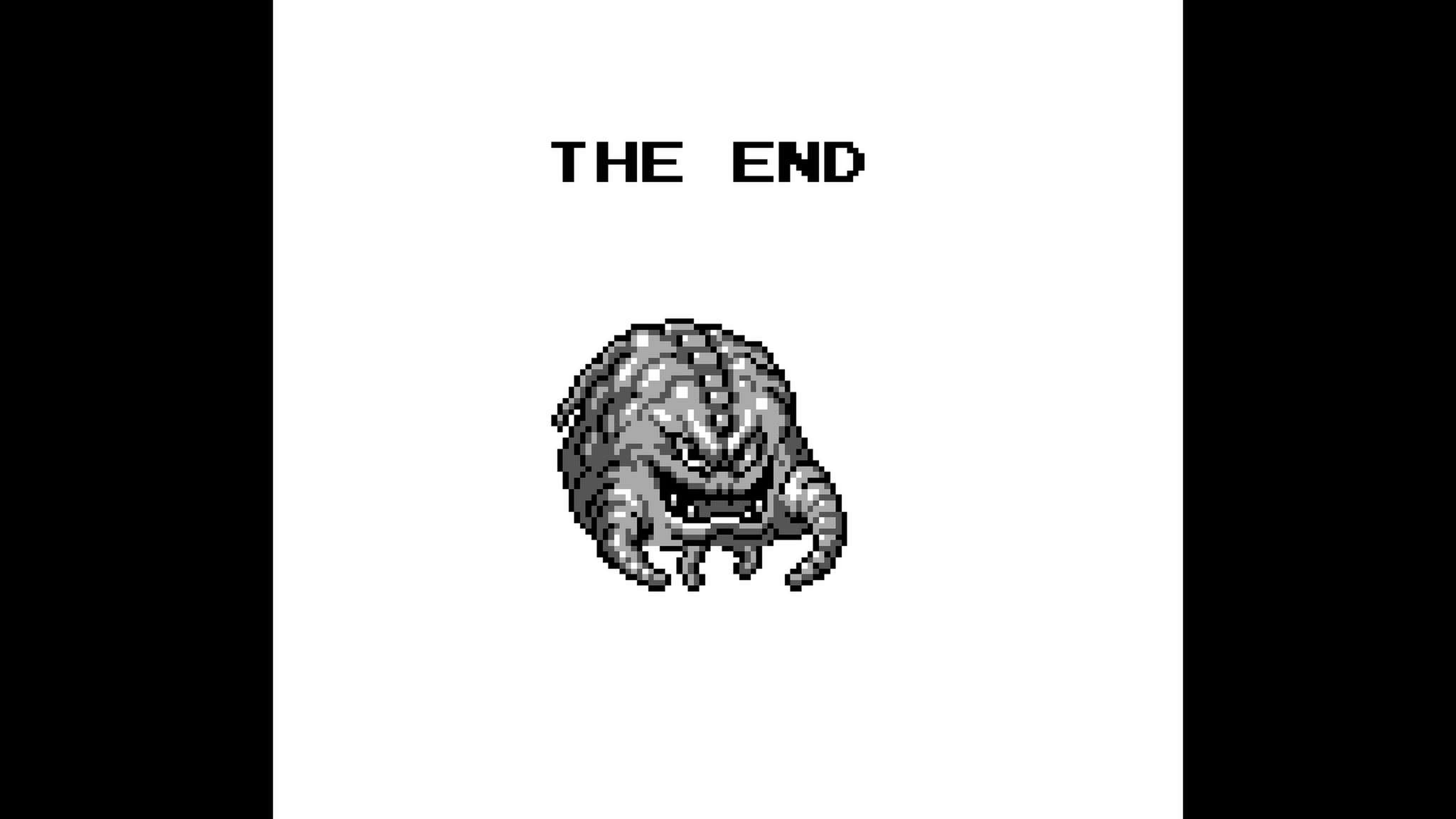
The SNES version of Tournament Fighters is the only fighter in Teenage Mutant Ninja Turtles: The Cowabunga Collection that supports online and has any playability. It’s like Street Fighter II and even has many of the same inputs for special moves and a similar combo system. Thankfully, modern game controllers are designed like a SNES pad which makes it accessible to any gamer today.
Sprites are their most bold and fluid compared to the lesser versions and has ten fighters and a few boss characters like Rat King, who looks massive and his most imposing appearance ever. Exclusive fighters include a generic ninja girl, the batted man Wingnut and a killer shark-guy. All versions of Tournament Fighters are shallow, but the SNES version is a decent try for its time and stands out.
Konami’s Teenage Mutant Ninja Turtles: The Cowabunga Collection is worth the price of admission. Some are duds, but most of them are excellent beatem-ups and a classic NES game that a lot of gamers grew up with. It’s nostalgia bait, but nostalgia is a valid feeling and can be cathartic- especially when it involves overcoming a game that used to crush you as a child.
Teenage Mutant Ninja Turtles: The Cowabunga Collection was reviewed on PlayStation 5 using a copy provided by Konami. You can find additional information about Niche Gamer’s review/ethics policy here. Teenage Mutant Ninja Turtles: The Cowabunga Collection is now available for Windows PC (via Steam), PlayStation 4, PlayStation 5, Nintendo Switch, Xbox One and Xbox Series X|S.